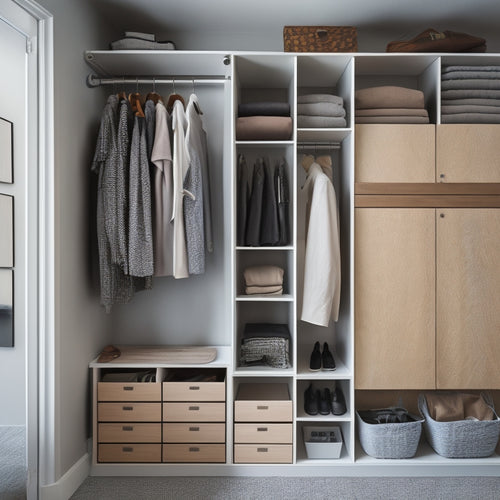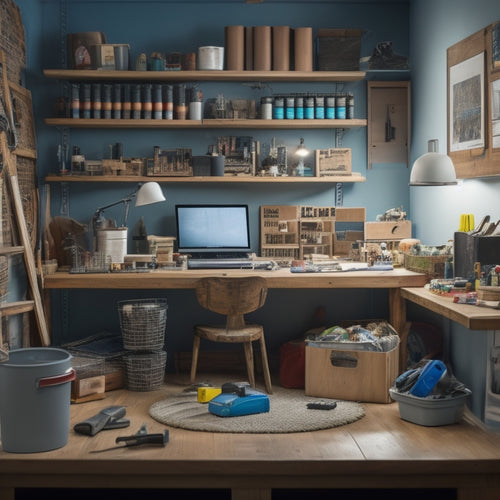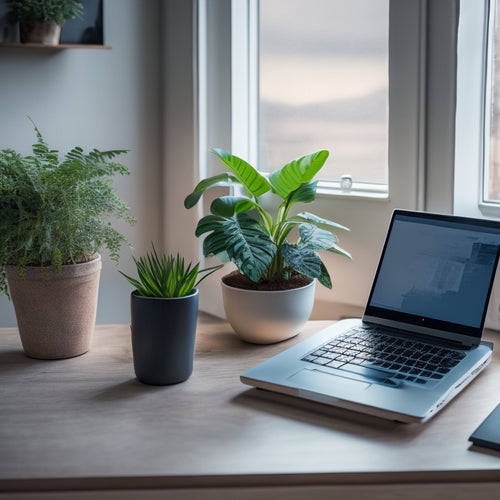
10 Best Decluttering Hacks for Tiny Spaces Online
Share
You can free up more space in your tiny home or apartment by decluttering your digital life. Start by controlling your digital space by organizing computer files and unsubscribing from unnecessary emails. Create a virtual landing strip to centralize frequently used files. Utilize online storage containers like Google Drive or Dropbox to synchronize files across devices. Designate a digital junk drawer to categorize digital clutter, and sort and purge digital files to free up space. Implement a cloud-based calendar to sync schedules and set reminders. By applying these digital decluttering hacks, you'll be able to uncover more strategies to optimize your digital space and transform your tiny space into a haven.
Key Takeaways
• Control digital clutter by organizing computer files, unsubscribing from unnecessary emails, and utilizing online storage containers like Google Drive or Dropbox.
• Designate a virtual landing strip as a central hub for frequently used files and organize digital information effectively.
• Create a digital junk drawer by categorizing clutter into folders with clear labels and establishing a consistent file naming system.
• Regularly sort and purge digital files to free up space, reduce file anxiety, and maintain a clean digital environment.
• Implement regular digital decluttering practices, such as scheduling weekly decluttering sessions, to maintain a clutter-free digital space.
Declutter Digital Clutter First
Before tackling physical clutter, start by decluttering your digital life, as a cluttered digital space can lead to mental fatigue and decreased productivity. You're likely guilty of digital hoarding, with a virtual mess of unused apps, forgotten files, and unread emails.
This digital overload isn't only overwhelming but also slows down your devices and steals your attention.
Take control of your digital space by starting with your computer files. Create clear folders and labels, and sort your documents into categories. Be ruthless – delete anything you no longer need or use.
Next, tackle your email inbox. Unsubscribe from newsletters and promotional emails that clog your inbox, and create filters to sort important messages.
Move on to your phone, deleting unused apps and organizing the ones you keep into logical categories.
Finally, consider implementing a password manager to simplify your online login process.
Create a Virtual Landing Strip
Now that you've decluttered your digital space, create a virtual landing strip to keep your digital life organized by designating a specific spot on your computer or cloud storage as a central hub for storing and accessing frequently used files and documents.
This hub will serve as your Virtual Inbox, where you can direct all incoming digital information, such as emails, receipts, and documents. Think of it as your Digital Gatekeeper, responsible for filtering and directing information to its designated place.
To set up your virtual landing strip, choose a specific folder or drive on your computer or cloud storage, and give it a clear and descriptive name. Then, create subfolders for different categories, such as 'Work,' 'Personal,' and 'Receipts.' This will help you quickly locate and access the files you need.
Make sure to set up clear labels and tags, so you can easily search and find specific documents. By designating a specific spot for your frequently used files, you'll be able to find what you need in a snap, saving you time and reducing digital clutter.
Utilize Online Storage Containers
Take advantage of online storage containers like Google Drive, Dropbox, or Microsoft OneDrive to store and synchronize your files across multiple devices, freeing up space on your computer and guaranteeing you can access your files from anywhere.
This Cloud Organization system allows you to access your files from any device with an internet connection, making it perfect for tiny spaces where storage is limited.
You can create Virtual Vaults for different categories of files, such as work documents, personal photos, or important documents, to keep your digital life organized.
By storing your files online, you'll no longer need to worry about running out of storage space on your devices, and you can even set up automatic backups to make sure your files are safe.
Plus, you can share files and folders with others, making collaboration a breeze.
With online storage containers, you can declutter your digital life and free up physical space in your tiny space.
Designate a Digital Junk Drawer
Now that you've got your digital storage containers set up, it's time to tackle the digital clutter that's been piling up.
You'll need to categorize your digital junk, set up organized storage folders, and establish a clear file naming system to keep everything in check.
Digital Clutter Categories
Designate a digital 'junk drawer' by categorizing your digital clutter into folders or files labeled with names like 'Unused Downloads,' 'Random Emails,' or 'Old Receipts,' allowing you to contain and confront the digital mess. This step is vital in tackling data overload and cyber hoarding, which can lead to feelings of overwhelm and anxiety.
Create categories that make sense to you, such as 'Work Projects,' 'Personal Documents,' or 'Unused Subscriptions.' Be specific and detailed, as this will help you identify what you need to keep and what you can delete.
For instance, you might've a folder for 'Unused Apps' or 'Old Passwords.' By categorizing your digital clutter, you'll be able to see what's taking up space and make informed decisions about what to keep or delete.
Storage Folders Setup
Set up a 'Someday' folder to capture items that don't have a home yet, like random files or emails that you're unsure about deleting. This digital junk drawer will help you declutter your digital space and free up mental energy.
Create custom labels for your folders to make them easily identifiable. For instance, you can label folders as 'Personal', 'Work', or 'Finance' to categorize your files.
To take it a step further, use color coding to differentiate between folders. Assign a specific color to each category, such as blue for personal files or green for financial documents. This visual system will help you quickly locate the files you need.
You can also use numbers or symbols to further categorize your folders. For example, you can use 'P1' for personal files and 'W2' for work documents.
File Naming System
Create a consistent file naming system by using a combination of keywords, dates, and descriptive phrases to clearly identify the contents of each file, making it easy to search and retrieve what you need. This will help you establish a solid foundation for your digital file organization.
When naming files, consider including the date created, project or category name, and a brief description of the file's contents. For example, '2022_March_Tax_Returns.pdf' or 'Client_Proposal_Smith_John.docx'.
Establishing a clear naming convention will save you time in the long run. You'll be able to quickly locate specific files and avoid duplicated efforts. It's also essential to maintain consistency across all your files and folders. This will enable you to develop muscle memory, making it easier to navigate your digital storage.
Sort and Purge Digital Files
Start by gathering all your devices and accounts that store digital files, from your phone and computer to cloud storage services like Google Drive or Dropbox.
It's time to confront your digital hoarding habits and tackle that overwhelming feeling of file anxiety. You're not alone; many of us struggle to keep our digital lives organized.
To begin, take a closer look at your digital files and ask yourself:
-
When was the last time I opened this file? Be honest, if it's been over a year, it's probably safe to delete.
-
Is this file redundant or duplicated elsewhere? Get rid of duplicates to avoid confusion.
-
Is this file outdated or no longer relevant? Delete outdated files to free up space and reduce clutter.
- Can I replace this file if I need it again? If the answer is yes, consider deleting it to declutter your digital space.
Set Up a Digital Filing System
With your digital files purged of unnecessary clutter, organize the remaining files into a logical structure by categorizing them into folders and subfolders that mirror your physical file system or make sense for your specific needs. This will help you maintain a paperless office, reducing physical storage needs and making it easier to access files on the go.
Create main folders for broad categories, such as 'Work,' 'Personal,' and 'Finances.' Then, create subfolders within each category to further organize your files. For example, under 'Work,' you might've subfolders for 'Projects,' 'Meetings,' and 'Reports.' Be sure to label your folders and subfolders clearly, so you can easily find what you need.
Don't forget to prioritize file security when setting up your digital filing system. Use strong passwords, enable two-factor authentication, and consider encrypting sensitive files. You should also regularly back up your files to an external hard drive or cloud storage service, in case your computer crashes or is compromised.
Implement a Cloud-Based Calendar
You can now take your organizational efforts to the next level by implementing a cloud-based calendar that syncs across all your devices, providing a centralized hub for scheduling and task management. This will enable you to access your calendar from anywhere, at any time, and stay on top of your commitments.
By using a cloud-based calendar, you can:
-
Sync your schedule across all devices, making sure you're always up-to-date and on track.
-
Set reminders and notifications to make certain you never miss a deadline or appointment.
-
Share your calendar with others, making it easy to coordinate with colleagues, friends, and family.
- Use calendar hacks like color-coding and categorization to visualize your tasks and prioritize your time.
With cloud syncing, you can rest assured that your calendar is always up-to-date, and you can access it from any device with an internet connection. By implementing these calendar hacks, you'll be able to optimize your time management, reduce stress, and increase productivity.
Manage Digital Subscriptions Efficiently
Take control of your digital subscriptions by centralizing them in a single location, making it easy to monitor and adjust your commitments. This will help you avoid Subscription Overload and keep track of your Billing Reminders. Create a spreadsheet or use a subscription management tool to keep all your digital subscriptions organized.
| Subscription | Billing Cycle | Cost |
|---|---|---|
| Netflix | Monthly | $15.99 |
| Spotify | Monthly | $9.99 |
| Adobe Creative Cloud | Yearly | $599.88 |
| Dropbox | Monthly | $11.99 |
| Amazon Prime | Yearly | $119.00 |
Organize Computer Desktop Icons
Five cluttered icons on your computer desktop can easily turn into fifty, making it impossible to find what you need when you need it. This phenomenon is known as Icon Overload, where your desktop becomes a digital mess, hindering your productivity.
To avoid this, you need to organize your computer desktop icons. Start by categorizing your icons into groups, such as work, personal, and entertainment. Then, create folders for each group and place the relevant icons inside.
Here are some tips to help you maintain a visually appealing desktop:
-
Use a consistent naming convention for your folders and files to make them easily identifiable.
-
Create a visual hierarchy by placing your most frequently used icons in the center of your screen and less important ones on the periphery.
-
Use icons with clear labels to avoid confusion and make it easy to identify what each icon represents.
- Limit the number of icons on your desktop to avoid clutter and maintain a clean visual space.
Schedule Regular Digital Decluttering
Organizing your computer desktop icons is just the first step in maintaining a clutter-free digital space, and to guarantee it stays that way, set aside a specific time each week to declutter your digital life.
This mindful maintenance habit will help you prevent digital clutter from piling up again. Allocate a specific time slot, say 30 minutes on Sundays, to review your digital files, emails, and apps.
During this digital detox, go through your computer files and delete or organize anything unnecessary. Unsubscribe from newsletters that no longer interest you, and uninstall apps you no longer use.
Take a closer look at your phone's storage and delete unused photos, videos, or documents. By dedicating a small chunk of time each week to digital decluttering, you'll maintain a sense of control over your digital space and reduce mental clutter.
Frequently Asked Questions
How Do I Deal With Sentimental Digital Files Like Old Photos?
You're struggling with digital hoarding, and it's time for memory management. Start by categorizing old photos into folders, then create a "maybe" folder for uncertain keeps, and set a deadline to review and delete or archive items.
Can I Use Multiple Cloud Storage Services at the Same Time?
Did you know 77% of people use cloud storage for personal files? You can use multiple cloud storage services, like Google Drive, Dropbox, and iCloud, simultaneously through cloud syncing, a practice known as "storage hopping," allowing you to access files across platforms.
Will Digital Decluttering Affect My Online Security and Privacy?
When digital decluttering, you'll manage sensitive info, so make sure you're using password protection and data encryption to safeguard your online security and privacy, avoiding data breaches and unauthorized access.
How Often Should I Back up My Digital Files and Data?
Did you know 1 in 10 people have lost files due to a lack of backup? You should back up your digital files daily, especially if you're prone to data hoarding, as cloud fails can happen; use 3-2-1 rule: 3 copies, 2 formats, 1 offsite.
Are There Any Digital Decluttering Tools and Apps Specifically for Seniors?
You'll find digital decluttering tools and apps designed specifically for seniors, focusing on accessibility features and senior-friendly design, such as Simplify, ElderDocs, and Senior Tech, which cater to your needs and ease of use.
Related Posts
-

7 Best Compact Closet Storage Ideas for Tiny Homes
You're looking for compact closet storage ideas to maximize your tiny home's space. Start by doubling your hanging sp...
-

What Makes Effective Online DIY Home Organization Courses?
You're about to reveal the secrets to transforming your living space into a serene and functional oasis, and it all b...
-

Declutter Your Desk With These Online Tutorials
You're just one organized desk away from boosting your productivity, reducing stress, and achieving a sense of contro...


